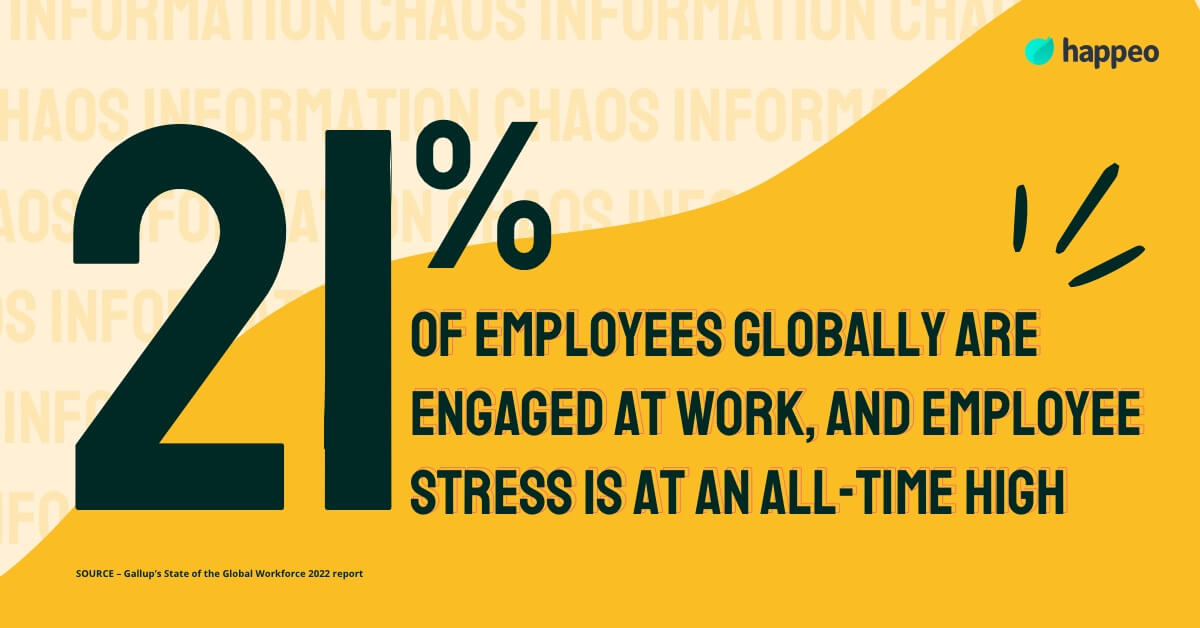Thousands of new startups are launched every single year. And each one of those jobs generates a huge amount of data and information that needs to be managed — leading to the need for proper organizational knowledge management, and effective internal communications. But the majority of fast-moving businesses still struggle when it comes to handling all the information they have to deal with and communicating effectively with their workforce.
It’s 7.30 pm on a Wednesday, and you’re ready to finally close down your computer. But before you can, a chat notification pops up. It's from a new teammate, one of 20 who joined two weeks ago. They’re asking for a piece of information they should have received during their onboarding.
Well, we’ve all been there. A lagging connection during an intro call or just a case of the information overload that normally comes with a new job can easily result in messages being missed.
“Just check the shared drive”, you start to type — but wait. Which shared drive is it in again? You log into your team's Google Drive and find that the version there is outdated. But it’s around here somewhere, so you start entering keywords into the search bar.
You’re suddenly overwhelmed by a gazillion hits: images and documents and HTML files, oh my.
And then it hits you: didn’t your coworker share that same file with another new starter last week? So, you jump back into one of your many public channels, track down the original message, and tag in your new colleague. Phew.
Except… it’s now 8 pm, you’re still at your desk, and you should have been enjoying a mid-week happy hour at least half an hour ago.
If any of this sounds familiar, you and your company could be in trouble. Information overload, inefficient communications, and poor knowledge management practices can add hours to your workday, and leave you feeling disengaged, disheartened, and just plain tired.
That’s the bad news. The good news, though, is that you’re not alone.
HR, we have a problem

Layoffs, hiring freezes, and budget cuts are on the rise across industries. Remote and hybrid working has become the new normal. And to top it all off, employees are leaving their jobs in droves: 4.2 million Americans quit their jobs in August 2022 — a full 70,000 more than the monthly average in 2019.
Employee burnout is a real worry too: according to Gallup’s State of the Global Workforce 2022 report, only 21% of employees globally are engaged at work, and employee stress is at an all-time high.
We’ve been hearing more and more from companies that are struggling to communicate internally and effectively manage knowledge and information in this new world of work. And without proper comms and democratized access to knowledge, it’s difficult to keep teams engaged and aligned with the company’s overall strategy.
On a mission to find out what’s going on, we surveyed 300 US companies about the state of their internal communications and information and knowledge management in 2022. Our findings? The majority of them — especially the 73% of respondents who represent fast-moving companies — are in a state of disorganization. Simply, they’re facing information chaos.
No, this isn’t just a new piece of marketing jargon — it’s a real problem for thousands of very real companies and their employees. Here’s what these companies have in common:
- They suffer from a culture of over-distribution and oversharing of information, without people understanding the consequences
- Even experienced employees have to wade through multiple tools for the information they need while avoiding an overwhelming number of duplicate and outdated files
- New joiners have a hard time finding information that’s scattered across several locations, and companies have a hard time storing information
- Knowledge is stored in departmental silos, resulting in missed information or duplicated work
- Miscommunication and disagreements within teams are rife, while collaboration and communication are less effective
More specifically, our survey found that:
- 66% of respondents need to search through 10+ tools to find the information they need
- 67% feel important information is slipping their attention
- 76% can’t perform their best work and are even missing deadlines
- 63% feel demoralized at work because of information-related issues
- At least 60%, especially in fast-moving companies, have seen their productivity suffer
We haven’t translated these findings into financial impacts. But it doesn’t take a crystal ball to see that over half of your workforce feeling disconnected and suffering from productivity loss doesn’t look good for your bottom line.
And we’re not just talking short-term impact here. If these companies don’t up their information-sharing and internal communication game, there’s a good chance they’ll see their long-term financials suffer too.
What causes information chaos?
As a company scales, it starts to accumulate a lot of information. Think about it: when a startup first launches, it may have a file for each of its handful of employees. Some website content. A few customer profiles and other marketing info the founder drew up to get started.
But as that company grows, the amount of information it needs just to keep the wheels moving rapidly expands too. And without solid communication and information management procedures in place, this can quickly get out of hand. The result: information chaos.
Plus, developing culture and connection in a hybrid or remote environment is never easy — particularly if your company is scaling fast. The communication methods that worked when you were a small company of 50 employees just won’t translate when you have 500, 1000, or more.
But scale-up leaders are busy. They’re focused on increasing headcount, seeking funding, and building the company’s strategy — which means that employee communications and culture can get pushed to the bottom of the priority list.
How to tackle information chaos

Internal communications have a big role to play in solving information chaos. After all, communication is at the heart of every organization. And the first step to managing information is to understand the three basic forms of communication that companies should be using:
- Static communications: This is the most traditional form of internal communications. It usually means one-way, one-to-company messages like corporate videos or intranet pages. They don’t often change unless the company’s strategy changes.
- Dynamic communications: These are two-way, one-to-team messages, like company-wide news and updates. They don’t need instant feedback, but they’re “alive” because people can share and react to them in their own time, at their own pace.
- Rapid communications: Rapid communications are probably the most common type of communication most employees face in their day-to-day work. They’re moment-specific, one-to-one or one-to-team messages usually sent through a chat or IM service.
Here’s the problem, though: many companies focus on only one type of communication, rather than using a combination of the three to create a winning formula for internal comms. So, how do you know if you’re using the three communication methods above effectively? You may have an internal comms problem if:
- Your company only communicates with its employees through top-down content like newsletters or static pages
- Your team is Slacking each other all day long, but there’s nothing in the way of dynamic communications
- You’re posting blog posts, articles, and intranet content and getting engagement… but your employees can’t find the information and documentation they need
Taking your A-game to A+

We all want to bring our A-game to work. But determination alone isn’t enough. You need a solid strategy and setup for managing information, democratizing knowledge, and transforming your internal communications.
What does that look like? Well, it’s different for every organization. But we like to think we know a thing or two about handling information chaos — and we believe the following steps can set you on the right path:
- Create a central source of truth: The key to managing knowledge and making sure your employees can access it whenever they need to is to put it all in one place. No more cluttered shared drives, and no more scrolling through emails for that attachment you got some time last week. Using one platform to store all of the knowledge your employees need to do their best work is essential to creating a healthy and productive employee experience.
- Connect everything together: Your employees probably use a number of different tools every day for collaboration, communication, and more. But using too many tools for too many different tasks means employees need to frequently context-switch, which can decrease productivity and cause confusion. Instead of overwhelming your team with too many standalone tools, integrate them into your central knowledge base. That way, users will have everything they need in one easy-access location.
- Combine communication methods: Too often, employees share files and information within their own teams, but not beyond them. This creates knowledge silos and can lead to lost time and duplicated work. To avoid this, look for opportunities to encourage bottom-up and cross-functional communication and information sharing. You should be using a combination of static, dynamic, and rapid communications to connect everyone together. And the stakes are high: research shows that companies whose employees feel highly connected to each other see a 7.4% boost in revenue growth every year.
- Analyze and optimize: Your communications strategy isn’t set in stone, and it’s vital that you continue to analyze its effects to make sure it’s still working for your organization. This means that companies need tools that give them an in-depth but easy-to-understand view of performance data so that they can spot (and fill) any gaps.
What does the future look like?

The world of knowledge management and internal communications is rapidly changing. Just 20 years ago, the level of connection companies can now achieve with their employees — even with everyone working from home — would have seemed unimaginable.
But what does the future hold? Here’s what the experts say:
“Employees should be given the same level of service and clarity that we give customers. Just like our customers, our teams want to engage with information that’s relevant to them. Companies that want to make it in the long run, should define knowledge management at an early stage, as it will provide the stability needed for their growth.”
— Salomé Bidaux, People Development Excellence Manager, Doctolib
"Research has shown that companies with more transparency and better information flow significantly outperform those without. As a result, there's a rising need among industries to develop lean knowledge processes to eliminate "waste" (i.e. too much, lost, or irrelevant information), and to effectively transform information into learnings that in turn can bring value to the business and its customers. We believe that optimizing knowledge acquisition and creating frictionless information flows are some of the core competencies to put at the heart of any future business strategy."
— Niko van Eeghen, VP of Product, Happeo
“You can bake a cake using a hammer, but it won’t taste very good. The same goes for tools at the workplace. Many companies have come to realize it’s key to their growth to deploy the right tool for the job. It has proven to make employees happier, more productive, and more efficient. The cloud helps employees use the tools they choose and prefer, rather than the tools they were given and told they had to use. As long as companies integrate these tools into the cloud properly, employees will also stay secure and protected while using them.”
— Andy Serwatuk, Director of Solutions Architecture, Onix
The journey to overcoming information chaos
If you want to see maximum growth for your organization (as well as happier and more engaged employees), overcoming information chaos is essential. It’s also a big task that’s not going to be achieved in a day or two. But you can start the process now by learning more about improving internal communications and knowledge management in your organization while employing the right tools to achieve optimal returns.
Want to dive deeper into our research on solving information chaos? Download our free report to learn more.









